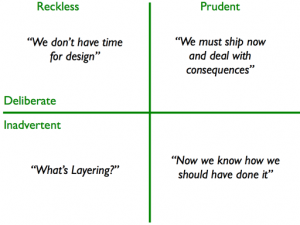Software development is software development. Most of the life cycle and quality issues faced in medical software are the same challenges for any software product. Technical Debt in Medical Software points out what technical debt is:
- Complexity
- Code Duplication
- Documentation Debt
- Testing Debt
- Architectural Debt
A Martin Fowler article is referenced that nicely identifies the source of technical debt:
The benefits of paying down the debt are:
- Increased R&D efficiency and improved time to market
- Hitting commitment dates
- Performance and technology upgrades
Of course if you don't want to pay it off, there's always the option to go bankrupt. This may have long-term advantages, but it will surely be a more expensive route. There is one statement in this regard that I think needs some qualification:
In this case the technical debt can be retired along with the legacy system, and like filing Chapter 11, you are no longer responsible to address all the sins of the past.
I know this refers to code sins, but just because you decide to do a re-write doesn't mean you no longer have responsibility for the legacy product. You still have customers using the old software that you're obligated to continue to support. For FDA approved medical software, this is a legal requirement. Most of the time this means that the legacy code will need to be maintained and periodically updated in the field, sometimes even after the "new" product is released. This just makes the cost of bankruptcy even higher.


Pingback: Tweets that mention Technical Debt in Medical Software | Bob on Medical Device Software -- Topsy.com
Pingback: Dew Drop – August 5, 2010 | Alvin Ashcraft's Morning Dew